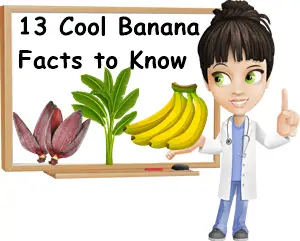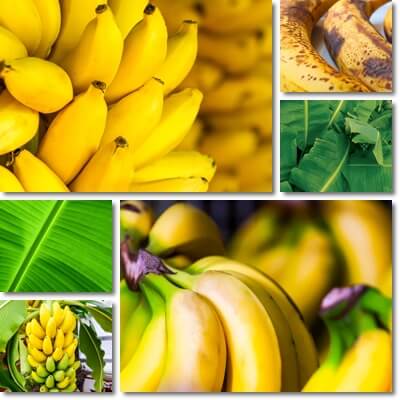There are many benefits to eating bananas, and just as many interesting facts about the tropical fruit. Did you know that bananas grow on palm-like trees that are not actually botanical trees? Or that there are many different colors of banana in addition to yellow? Or that you can eat not just the fruit, but also the peel, flowers, leaves and even tree core? Read on to find out 13 of the coolest, most interesting facts about bananas.
(1) Bananas come in many colors
Did you know there are more colors to bananas than just yellow? Believe it or not, there are pink and red bananas, purple bananas, brown bananas and even green and white striped bananas. Some red bananas go through a succession of colors as they ripen: green to yellow to orange to dark red. There are also bananas with different pulp colors, such as yellow bananas with a bright salmon-pink pulp. Or Fei bananas with orange-red-burgundy peel and orange flesh. The more unusual banana colors are not genetically modified, but occur naturally in the wild.

(2) Bananas don’t grow on trees
Being a tropical fruit, you’d think the banana would grow on a palm tree. But no, bananas don’t grow on trees – they grow on a flowering herb. Granted, the banana plant may look like a tree, but it’s actually botanically a flowering herb. One of the largest herbs in the world, the banana plant has quite the tropical flair, with a palm tree-like appearance.
(3) You can eat the core of the banana tree
Did you know that the banana ‘tree’ itself is edible? Botanically speaking, the trunk of the banana ‘tree’ is actually a false stem. And you can eat the inner core of the banana ‘tree’ like you would a vegetable. The core is called a ‘banana pith’ or ‘banana stem’ and is a culinary vegetable similar to hearts of palm harvested from coconut trees, acai trees and other types of palm trees.
(4) You can eat banana flowers
Edible flowers are a common occurrence – you can eat dandelions, marigolds, false acacia flowers, zucchini and pumpkin flowers, and also banana flowers. Banana flowers, also called banana blossoms, are more unusual looking, extremely large, cone-shaped, reddish-brown to crimson or dark purple. Each flower consists of tightly packed leaves called bracts, that look similar to corn in husk, with a light yellow-green banana heart in the center, similar to artichoke hearts.
The banana flower is edible in its entirety, although most people only like to eat the more tender banana hearts in the center of the flower. You can use the leaves as plates, and serve food in them. Depending on how tender they are, you can eat banana flowers raw or cooked.

(5) You can eat banana peels
While it’s not common, at least not in the West, know that you can absolutely eat banana peels. The peels are usually cooked along with the fruit, and only eaten when bananas are consumed as culinary vegetables. Plantains, which are starchier varieties of banana that are less pleasant to eat raw, and unripe, green bananas are commonly eaten as culinary vegetables in many parts of the world. The fruits are washed, chopped and added to stir-fries, curries, rice and more dishes, peel and pulp. And did you know that you can also eat pumpkin rind?
(6) Bananas are botanical berries
It’s pretty clear the bananas are fruits, but what kind of fruits? Bananas are botanical berries, like blueberries, gooseberries, grapes, tomatoes, cucumbers, zucchini, pumpkin, avocado and coffee. Contrary to popular belief, blackberries, strawberries, raspberries and mulberries are not actual berries.
You might be interested: Is Banana a Fruit or Vegetables ?
(7) You can make paper from bananas
Did you know that you can make paper from various parts of the banana plant? Banana stems, and the peels from banana fruits that are deemed unsuitable for consumption and would otherwise be discarded, can be processed and the fibers from them used to make paper. Paper is also made from banana plant bark.
(8) You can use banana leaves as plates and umbrellas
Banana leaves naturally grow very large, and the largest of them can be used as umbrellas, to protect yourself from the rain. You can also use banana leaves as plates, to store and serve food, or even cook food in them – they can be used to store food that is boiled, steamed or baked. Banana leaves are naturally waterproof, hence their unusual uses.
(9) You can eat unripe green bananas as vegetables
If you are looking for new vegetables to try, then you may want to consider bananas. While they are botanical fruits, bananas can also be used as culinary vegetables. Unripe, green bananas, and plantains, that are firm and starchy can be chopped, stem removed, seasoned and cooked – fried, boiled, steamed or baked. You can pair them with Asian-style vegetable mixes with bamboo shoots, onions, baby corn, and rice.
(10) Bananas don’t have a season
Bananas are tropical fruits that grow in warm environments. They have the benefit of being cultivated extensively which makes them available all year round. Some people call them off-season foods because they don’t have a season.
See more foods in season all year.
(11) Bananas can be seedless or seeded
A lot of times, bananas from commercial production are virtually seedless, with a clean, cream to yellow flesh. If not completely seedless, they may preserve remnants of seeds in tiny, brown-black speckles scattered across the center of the pulp. However, bananas growing naturally in the wild have seeds – these are quite large, and in enough numbers that they hinder the eating of the fruit. Banana seeds are hard enough to crack seeds.
(12) Bananas can be fuzzy
Did you know that bananas with fuzzy peel exist? Fuzzy bananas, also called hairy bananas, are a wild variety of banana known under the scientific name: Musa velutina. They grow mostly in the wild, but have been picked up for cultivation as ornamentals
However, fuzzy bananas are perfectly edible – they have a soft, sweet, pleasantly scented, albeit somewhat starchy and faintly sour pulp, and pink 0r fuchsia, hairy skin. Fruits of the variety have tough, large, black seeds scattered across the pulp and measure about 8 cm in length. They are known to peel back when ripe.
(13) You can make tea from bananas
Did you know that you can make tea from bananas? You can make tea from just banana peels, or from whole bananas, peels and fruit. You can also make tea from bananas flowers. Banana tea made from the whole fruit is good for sleep problems and blood pressure, among other benefits for health.
